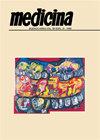[老年抗凝患者继发于肌肉撕裂的腿部筋膜室综合征]。
IF 0.6
4区 医学
Q3 MEDICINE, GENERAL & INTERNAL
Medicina-buenos Aires
Pub Date : 2025-01-01
引用次数: 0
摘要
筋膜室综合征是一种临床外科疾病,其特征是筋膜室内压力增加,导致进行性组织损伤,如果不及时治疗,可能会产生毁灭性的后果。高能量创伤是最常见的原因,尽管在虚弱和抗凝患者中,它可以由日常活动引起。我们报告了一例63岁的男性,患有多种合并症和抗凝治疗,他发展为继发于肌肉撕裂的筋膜室综合征,需要减压筋膜切开术。对于机制不典型的抗凝患者,早期怀疑筋膜室综合征对于避免诊断延误和确保及时、适当的治疗至关重要。本文章由计算机程序翻译,如有差异,请以英文原文为准。
[Compartment syndrome of the leg secondary to a muscle tear in an anticoagulated elderly patient].
Compartment syndrome is a clinical-surgical condition characterized by an increase in intracompartmental pressure that leads to progressive tissue damage and can have devastating consequences if not treated promptly. High-energy trauma is the most common cause, though in frail and anticoagulated patients, it can arise from daily activities. We present the case of a 63-year-old man with multiple comorbidities and anticoagulant therapy who developed compartment syndrome secondary to a muscle tear and required decompressive fasciotomy. Early suspicion of compartment syndrome in anticoagulated patients with atypical mechanisms is essential to avoid diagnostic delays and ensure timely, appropriate treatment.
求助全文
通过发布文献求助,成功后即可免费获取论文全文。
去求助
来源期刊

Medicina-buenos Aires
医学-医学:内科
CiteScore
1.30
自引率
12.50%
发文量
0
审稿时长
6-12 weeks
期刊介绍:
Information not localized
 求助内容:
求助内容: 应助结果提醒方式:
应助结果提醒方式:


